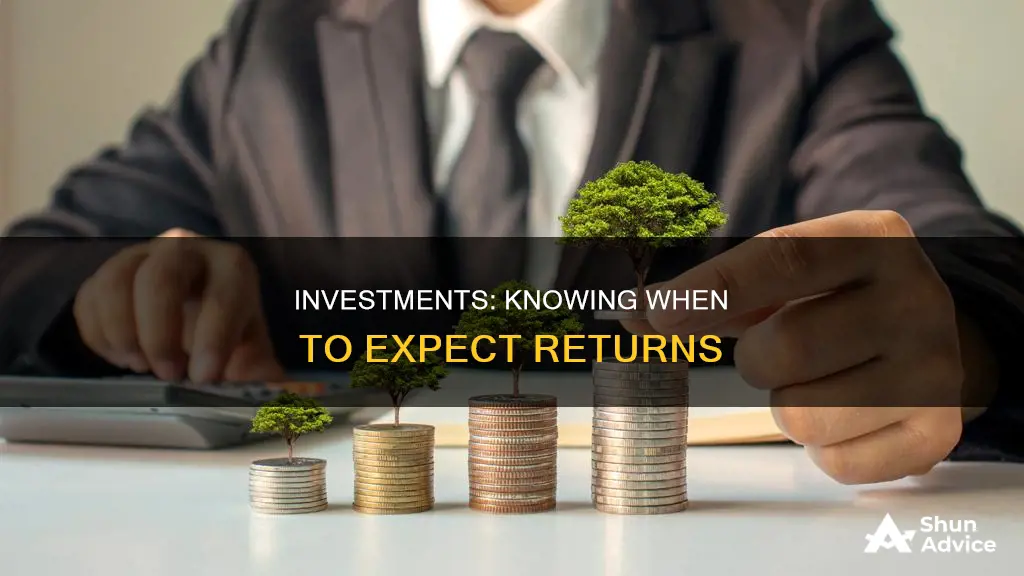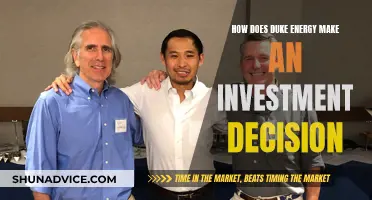
How long you should invest for depends on your financial goals, risk tolerance, and investment strategy. Generally, the longer you invest, the more time your money has to grow through compound interest. While some investments can yield high returns in the short term, others may take years to produce significant returns. It's important to understand the risks and potential returns of different investments and to diversify your portfolio to minimize risk. Starting early, investing regularly, and sticking to a long-term plan can help you achieve your financial goals.
| Characteristics | Values |
|---|---|
| Investment time frame | The longer you have to invest, the more time you have to take advantage of compound interest. |
| Initial investment amount | How much you plan to invest to start. |
| Planned regular contributions | How much and how often you plan to contribute. |
| Investment timeline | How long you plan to leave your money in your investment. |
| Expected rate of return | The S&P 500 has a historical average annual total return of about 10%. |
| Frequency of compounding | Some financial products, like savings accounts, will have a specific compounding frequency. Stock market investments compound daily. |
What You'll Learn

How long you should invest for
When it comes to investing, the general consensus is that the earlier you start, the better. The longer you invest for, the more time you have to take advantage of compound interest, which can turn modest savings into larger nest eggs over time.
For example, if you're saving for a house, you might invest for a few years to build up a down payment. On the other hand, if you're investing for retirement, you might invest for several decades to build a substantial nest egg that will last you through your golden years.
It's important to remember that investing is a long-term endeavour, and short-term market fluctuations shouldn't deter you from staying invested. Historical data shows that the stock market tends to go up over time, and time in the market is more important than timing the market.
Additionally, the type of investments you choose will also impact how long you should invest. For instance, stocks are typically considered a long-term investment due to their volatile nature, while savings accounts or certificates of deposit (CDs) are suitable for shorter-term goals.
Finally, it's worth noting that investing carries inherent risks, and there is no one-size-fits-all approach to determining how long you should invest. Consult a financial advisor to help you create an investment plan that aligns with your goals, risk tolerance, and time horizon.
TD Ameritrade's Essential Portfolio: What ETFs are in Focus?
You may want to see also

The impact of compound interest
Compound interest is a powerful tool that can significantly boost your investment returns over time. It involves earning or owing interest on both the initial principal amount and the accumulated interest from previous periods. This means that your returns can earn their own returns, leading to accelerated growth in your investments.
Here's an example to illustrate the power of compound interest. Let's say you invest $1,000 in a savings account with an annual interest rate of 5%. In the first year, you earn $50 in interest, resulting in a new balance of $1,050. In the second year, the 5% interest is calculated on this larger balance, giving you $52.50 in interest and a new balance of $1,102.50. This process continues, and the growth of your savings account balance accelerates over time. If you leave this investment untouched for 30 years, you'll end up with a balance of $4,321.94, even though you only contributed $1,000.
The key factors that impact compound interest are the interest rate, the starting principal, the frequency of compounding, the duration of the investment, and any deposits or withdrawals made. The more frequent the compounding periods, the larger the effect of compounding. For example, if the interest on the $1,000 savings account is compounded daily instead of annually, the ending balance after 30 years would be $4,481.23, resulting in an additional $160 in interest.
Compound interest can also work against you when it comes to debt. For example, credit card debt can quickly accumulate due to compound interest. Each month, your credit card company charges interest on your outstanding balance. If you don't pay off this interest, it gets added to your balance, and the next month's interest is calculated on this higher amount. This cycle can lead to your credit card debt growing exponentially over time.
Therefore, it's essential to understand the power of compound interest when making investment decisions or managing debt. It can be a powerful tool for building wealth over the long term, but it can also work against you if you're not careful.
Making Trades on You Invest: A Step-by-Step Guide
You may want to see also

Risk and return
The risk-return tradeoff principle states that invested money can only render higher profits if the investor accepts a higher possibility of losses. For example, a startup business could become a multimillion-dollar company, or it could go bankrupt. If you invest in the stock of this company, you could make a fortune or lose everything.
Different types of risks include project-specific risk, industry-specific risk, competitive risk, international risk, and market risk.
There are several ways to calculate the risk-return tradeoff, including alpha, beta, and Sharpe ratios. The alpha ratio measures excess returns on an investment. The beta ratio shows the correlation between the stock and the benchmark that determines the overall market. The Sharpe ratio helps determine whether the investment risk is worth the reward.
Time also plays a role in the risk-return tradeoff. For example, if an investor can invest in equities over the long term, they have the potential to recover from bear markets and participate in bull markets. On the other hand, if an investor can only invest for a short time, the same equities present a higher-risk proposition.
Diversification is another way to manage risk and return. By diversifying their portfolio, investors can reduce the overall risk while maintaining the potential for superior returns. Each investment in a diversified portfolio represents a small percentage of that portfolio, so any risk that affects the value of a particular investment will only have a small impact on the overall portfolio.
Additionally, investors should consider their risk tolerance and financial goals when deciding how much risk to take on. Some investors will forgo a significant rate of return to achieve lower risk. For example, U.S. Treasurys are considered risk-free assets, but they would likely underperform stock investing.
Understanding the relationship between risk and return is essential for investors to make informed decisions. By evaluating their risk tolerance and financial goals, investors can determine how much risk they are willing to take on and adjust their portfolios accordingly.
Owner's Investment and Revenues: Equity Growth Factors
You may want to see also

Starting balance
The starting balance of an investment is the principal amount, or the initial sum, that serves as the foundation for investing. It is the amount of money that an individual has already saved up or received as a gift, bonus, or inheritance, which they plan to use as their initial investment.
Different types of investments have varying minimum starting balance requirements. For instance, most brokerage firms that offer mutual funds and index funds typically require a starting balance ranging from a few hundred dollars to $1,000 or more. In contrast, purchasing individual equities and bonds usually requires a smaller initial investment.
The starting balance is crucial because it determines the potential for investment growth over time. The larger the starting balance, the more opportunity there is for compound interest to accumulate and generate higher returns. However, it's important to note that investing early, even with a small starting balance, can be more advantageous than delaying investments while waiting for a larger sum.
Additionally, the starting balance is just one factor among several that influence investment outcomes. Other factors include the rate of return, contribution frequency and amount, investment time frame, and the level of risk associated with the chosen investment vehicle.
It is also important to remember that investing carries inherent risks, and there is no guarantee that any investment will perform as expected. Diversification and a long-term perspective are often recommended as strategies to mitigate risk and maximise the potential for investment growth.
Invest Wisely: A Guide to Savings in Australia
You may want to see also

Contribution frequency
The contribution frequency is how often you plan to contribute to your investments. This can be done weekly, bi-weekly, monthly, semi-annually, or annually. The contribution frequency you choose will impact how much your money grows and how fast.
For example, if you are paid every other week, you may choose to contribute bi-weekly. Alternatively, if you only manage to contribute to your investments once a year, you may choose an annual contribution frequency.
It is important to note that the more frequently you contribute, the faster your money will grow due to the power of compound interest. Compound interest is when the interest you earn on your investments also earns interest over time. Therefore, contributing more frequently can lead to higher returns on your investments.
When deciding on a contribution frequency, it is essential to consider your financial situation and goals. If you are able to contribute more frequently, you may see higher returns on your investments over time. However, if you can only contribute annually, that is still a good place to start and will help you build your investment portfolio over time.
Additionally, it is worth mentioning that contribution frequency is just one factor that impacts the performance of your investments. Other factors include the amount you contribute, your rate of return, and the length of time you have to save. By considering all these factors together, you can make informed decisions about your investment contributions and work towards achieving your financial goals.
Building a Solid Investment Portfolio: A Beginner's Guide
You may want to see also
Frequently asked questions
The rule of 72 is a shortcut used by investors to determine how long it will take for their investment to double based on a fixed annual rate of return. By dividing 72 by the fixed rate of return, you can get a rough estimate of the number of years it will take for your initial investment to double.
Compound interest plays a crucial role in investments, as it allows your interest earnings to generate even more interest over time. This exponential growth can significantly increase your investment returns, especially over longer periods.
It's important to assess your risk tolerance, investment time frame, starting balance, contribution frequency, and expected rate of return. These factors will influence the potential returns and risks associated with your investments.
Generally, the closer you are to retirement, the more conservative your investment strategy should become. Older investors typically reduce their exposure to risky assets like stocks and shift towards more stable options like bonds.
To calculate ROI, subtract the initial investment amount from the final value of your investment, then divide this figure by the cost of the investment, and finally multiply the result by 100. However, note that ROI doesn't account for the time factor.







